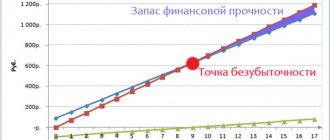Receivables are nothing more than the unclosed financial obligations of counterparties (individuals and legal entities). This type of debt is associated with indirect costs in the profit of the loan holder, since he does not have cash in an amount equal to the receivable, and they cannot be used for the benefit of the business entity. An analysis of accounts receivable turnover characterizes the company’s existing relationships with its contract partners, as well as the duration and, accordingly, the speed of converting goods into cash.
The concept of accounts receivable turnover
Debt refers to monetary obligations that someone has to businesses and individuals. For example, this is a payment that has not yet been received by the company. This is an indirect loss in the income of the enterprise, which may or may not be compensated if for some reason the debtor of the organization is unable to fulfill its financial obligations.
There can be two varieties:
- Normal. The one that was repaid in due time.
- Overdue. Debt that is not paid within the specified time.
Debt turnover is a coefficient that characterizes the effectiveness of a company’s cooperation with its counterparties. It shows how quickly raw materials are transformed into money, and becomes a real part of capital.
VIDEO: How to organize operational control of receivables
Dmitry Ginkulov, Deputy General Director for Economics and Finance, tells in the video how to organize operational control of receivables.
https://youtu.be/TBfvlqc-DHY
Use step-by-step guides:
- Excel for CFO
- Management accounting in your company
- Summing up the half year
To assess the performance of an enterprise, you need to know the indicators of its business activity. One of them is accounts receivable turnover (AR). This ratio shows the rate at which goods or services are converted into money. It helps determine the strategy for increasing the profitability of the company.
The concept of the period of ODZ
The turnover period of accounts receivable can also be called the time of its return. It shows the average payment delay time. LAP is determined by how intensively the assets or liabilities are used.
Debt turnover indicators can demonstrate how the company's economic performance has changed. This is possible if you use the following methods:
- increase revenue after selling products;
- reduce the performance indicators for the selected period.
To do this, you can provide a loan to another company in the early stages, having carried out its verification. At the same time, credit policy that affects debt debt is:
- Conservative. Control is carried out as strictly as possible, and all borrowers undergo strict verification.
- Moderate. The company's risk is average.
- Aggressive. There are minimal conditions and no checks, so the risk of not getting your money is huge.
As a result, the PPV can be high, medium and low.
Bottom line
The receivables turnover indicator is an important indicator of financial activity, indicating the productivity of the selected enterprise and counterparty. This coefficient is especially important for employees and company management to analyze the state of the enterprise. An increased indicator indicates that the company's sales volumes have increased or accounts receivable have decreased.
This ratio is directly related to the financial status of the organization and its liquidity; the higher the indicator, the more stable and profitable the enterprise. The bottom line is that money for goods provided comes to the company’s account faster, which means it can be included in further turnover to increase profits or repay loans.
https://youtu.be/tVXgEOoxs48
How to calculate the turnover period
In simple terms, POPL is the term for repaying the debt. With its help you can find out the average payment deferment time. That is, the receivables turnover period is determined by the ratio between the number of days when the debt was not repaid in the estimated time and the value of the receivables.
To accurately calculate the period under consideration:
- DPR = duration of period/DPR
For clarity, each value must be further analyzed. For example, receivables are accounts receivable. Its turnover is the speed of debt repayment. It is equal to the ratio of sales revenue to the average volume of proceeds for the period that is being analyzed.
Considered to be the formula:
- Receivables turnover in days = Revenue/((Results at the beginning - Receivables at the end)/2)
This formula allows you to determine how many times and in what volume the company received revenue for services provided. Estimated time may vary. For example, from a month to a quarter or a year. Balance sheets can be used as a source of information. You can also use the profit and loss statement that the company had.
https://youtu.be/jkD3RZ7A1Fc
True, there are nuances depending on the country where this practice is used. For example, in Western countries there is a different technology for determining the period under consideration. In particular:
- apply the amount of debt that was formed at the end of the period under study;
- Doubtful debts are calculated from the total value in order to obtain more objective results.
The result is the following formula:
- ODZ = (DZ - questionable DS)/B*365 days
In domestic practice, such a formula is rarely used.
Analyzing the indicator
The next important step that must be taken after the average receivables turnover period has been determined is to analyze them correctly. For analysis, average indicators are used with which the results are compared.
The following factors may affect the PAP:
- what kind of remote control was at the beginning of the analyzed time;
- how much finance was received;
- accrued profit for the specified time;
- number of days in the reporting period.
You need to find out your actual and planned income. These indicators demonstrate how effective management's policies are.
It is interesting that the planned income may differ from the established standard:
- deviation of actual from planned;
- difference between planned and normative.
This calculation will allow you to avoid errors in the preparation of documentation.
Calculation formula
The formula for calculating the debt ratio is as follows:
Accounts receivable turnover ratio = Total profit from the sale of goods / Average debt in accounts receivable.
It is important to remember that the average , so the number at the beginning of the required period must be taken and added to the result at the end of the period, then everything must be divided by two. Also, the selected period may not be one year, but, for example, a quarter or a month.
What if the rate goes down?
If the receivables turnover time is falling, this is a good sign. If the duration of debt turnover increases, this is a good sign that the company has conscientious debtors who fulfill their obligations according to the terms of the contract. In addition, he indicates that the head of the company chose the right path, competently implemented the credit policy and has an established collection system. But at the same time, it is important not to put too much pressure on counterparties, otherwise they will refuse to cooperate with an overly demanding partner. Demand for their products will fall, which means there will be fewer avenues for distribution. It is important to properly maintain a balance.
What if the rate increases
If the duration of debt turnover increases, this is a sign that the company has unscrupulous debtors who fail to fulfill their obligations according to the terms of the contract. Typically, this result is observed if the amount of receivables accumulates critically. That is, the company's bills are not paid on time.
This often means that the company's products are not in great demand on the market or their quality is not high enough to compete with other companies. Also, such an indicator may indicate an ineffective management apparatus that cannot adequately build relationships with debtors. For example, too much loyalty.
But a decline can mean more than just bad things. Often receivables fall if the company expands its sales market or expands itself. This can be corrected by increasing working capital.
A properly conducted analysis will provide comprehensive information about how well or poorly the company is doing. If overdue debts continue to accumulate, it is advisable to write them off. Thus, the company's balance sheet will be aligned. But in order to do this on time, you need to regularly analyze and make adjustments if alarming factors appear.
https://youtu.be/IcnjCmxWQDo
Receivable turnover
Definition
Receivable turnover ratio measures the speed of repayment of an organization's receivables, how quickly the organization receives payment for goods (work, services) sold from its customers.
The accounts receivable turnover ratio shows how many times during a period (year) the organization received payment from customers in the amount of the average balance of unpaid debt. The indicator measures the effectiveness of working with customers in terms of collecting receivables, and also reflects the organization's policy regarding credit sales.
Calculation (formula)
Accounts receivable turnover (ratio) = Revenue / Average accounts receivable balance
The average balance of accounts receivable is calculated as the amount of accounts receivable from customers according to the balance sheet at the beginning and end of the analyzed period, divided by 2.
It is also common to calculate the indicator not in the form of a coefficient, but in the form of the number of days during which the receivables remain unpaid:
Accounts receivable turnover in days = 365 / Accounts receivable turnover ratio
Normal value
For accounts receivable turnover, as well as for other turnover indicators, there are no clear standards, since they strongly depend on industry characteristics and the technology of the enterprise. But in any case, the higher the coefficient, i.e. The faster customers pay off their debt, the better for the organization. At the same time, effective activity is not necessarily accompanied by high turnover. For example, when selling on credit, the accounts receivable balance will be high, and the turnover ratio will be correspondingly low.
About accounts receivable turnover in English, read the article “Receivable Turnover Ratio”.
Inventory turnover
Inventory turnover shows how many times during the analyzed period the organization used the average available inventory balance.
This indicator characterizes the quality of inventories and the efficiency of their management, and allows us to identify the remains of unused, obsolete or substandard inventories.
Moreover, in this case, stocks mean both commodity stocks (stocks of finished products) and production stocks (stocks of raw materials).
Inventory turnover ratio formula:
Inventory turnover can be calculated in two ways.
1. as the ratio of cost of sales to the average annual inventory balance:
Inventory turnover (ratio) = Cost of sales / Average annual inventory balance
The average annual balance is calculated as the sum of inventories on the balance sheet at the beginning and end of the year divided by 2.
Inventory turnover ratio = line 2120/(line 1210 at the beginning of the year + line 1210 at the end of the year) * 0.5
Where:
Page 2120 - cost of sales from form No. 2;
Page 1210 - accounts payable from form No. 1.
2. as the ratio of sales revenue to the average annual inventory balance:
Inventory turnover = Revenue / Average annual inventory balance
Inventory turnover ratio = line 2110/(line 1210 at the beginning of the year + line 1210 at the end of the year) * 0.5
Where:
Page 2110 — revenue from form No. 2;
Page 1210 - accounts payable from form No. 1.
There are no standards for inventory turnover indicators.









